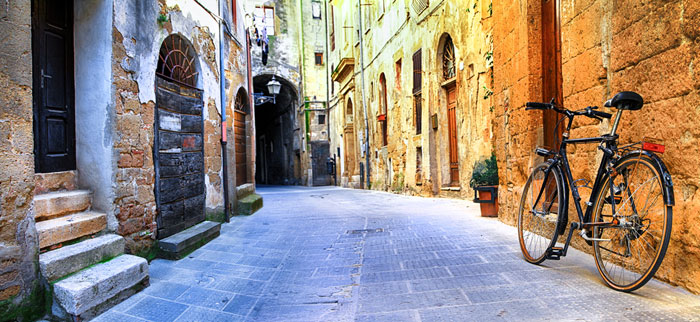Pitigliano travel guide
The skies appear bigger in the Alta Maremma; vast and empty, with just the occasional hawk swooping into view. Nothing at all to prepare you for your first view of Pitigliano, surrounded almost completely by a sunken, wooded gorge.
Almost midway between Orbetello on the coast and Orvieto in southern Umbria, this has been fertile farmland for millennia. Right at its heart, Pitigliano seems to grow from its extraordinary crag.
Even if you look closely, it’s hard to tell where the houses end and the bedrock begins. This labyrinth of narrow streets, stone exterior staircases and vaulted passages is quite unlike anywhere else in Tuscany.
In the Beginning…
People lived around Pitigliano in prehistory, and many Etruscan settlements were in the area. But the medieval era was when Pitigliano really made a splash.
The town is first documented in 1061. In following centuries, the big hitters of the Maremma all ruled over it. The Aldobrandeschi counts used Pitigliano as a fortified bulwark against Orvieto. Later it was under Orsini family control — and became their capital in 1293, even holding out against the Sienese when most Orsini lands in the Maremma fell.
The Medici Grand Dukes of Tuscany took over in 1604. They resisted an assault by papal troops 40 years later.
Under the Medici and later Lorraine Grand Dukes, Pitigliano cemented an association with Tuscany’s Jews which had begun in the mid-1500s. Jews lived here in relative peace, enjoying more rights and freedoms in culture, politics and economics than almost anywhere else in central Italy. Pitigliano was even nicknamed “Little Jerusalem”.
Visit This
Pitigliano’s Jewish heritage is preserved at La Piccola Gerusalemme, a living exhibition in a couple of garret-like lanes that were once the ghetto. Just off Via Zuccarelli, stepped streets terrace into the hill, with the remains of the ritual bath and kosher bakery cut from the rock.
A harsh economic climate in the early 20th century had sent the Maremma’s Jewish community into decline. Fascism accelerated the process, although many Pitigliano families protected local Jews with whom a four-century cultural bond had formed.

Uphill from here, the town’s Duomo is an unexpectedly grand affair, on a small square in the heart of the town. Baroque inside and out, it houses art by Francesco Vanni (1563–1610).
The town’s most imposing secular building is the crenellated 13th-century Palazzo Orsini. It houses the civic museum, with the municipal art and craftwares collection. The arched aqueduct was also built under Orsini patronage.
Eat This
Typical dishes of the Maremma dominate the menu at Hostaria dal Ceccottino, including buglione d’agnello (lamb with tomato and red garlic) and cinghiale alla cacciatora (wild boar stewed with olives).
Just out of sight, a network of deep, open-air passages have been sliced deep into the tufa landscape
Buy This
Pitigliano’s handful of ceramics and craft shops line Via Roma.
This is also the place to buy a bottle of the distinct local wine. One light native red is made with the Ciliegiolo (“cherry-like”) grape.The classic Maremma white, Bianco di Pitigliano, is light and seafood friendly, and made from a local varietal of the Trebbiano grape.
Since ancient times, Pitigliano’s wines have been stored and matured in the caves below the town.
The Great Outdoors: Etruscan Vie Cave
There’s miles and miles of empty countryside around Pitigliano. But just out of sight, a network of deep, open-air passages have been sliced deep into the tufa landscape. These are the vie cave, the sunken pathways, of the ancient Etruscans. Some are up to 20 metres deep in stretches, but never much more than a few metres wide.
There’s still debate about what the Etruscans actually used them for. Were they for religious rites or processions, drainage channels, or just a convenient way to move livestock out of sight of rustlers? The most impressive, the Via Cava di San Giuseppe, begins close to the roadside just outside Pitigliano.
Festivals
This path plays a key role in Pitigliano’s iconic festival, the Torciata di San Giuseppe. It is held on the feast day of St. Joseph (March 19), but there’s a distinct pagan, even Druidic flavour to celebrations, including a torchlit parade along the namesake via cava ending in a bonfire on Piazza Garibaldi. Think a Tuscan version of weird 1971 thriller, “The Wicker Man” and you’re about right.
Out of Town: Sorano & Sovana
Five miles to the north-east, Sorano is dominated by its vast Renaissance Fortezza (now a museum). A circular road through the walled medieval old town below climbs to a panoramic terrace. Look closely and you can see prehistoric rock dwellings and burial chambers in the surrounding cliffs.
Sorano’s Bottega del Legno sells seasoned olive wood carved and whittled into all kinds of useful objects, from pestle-and-mortars to cutlery and hair grips.
Sovana, 4 miles north of Pitigliano, was once the seat of powerful Aldobrandeschi nobles. It’s now a pretty village, with a Roman street and a now-ruined castle beside the S22 road.
A pair of Lombard churches — parts of Santa Maria Maggiore date to the 9th century — are decorated with intricate Romanesque stonework.
Beside the road just west of Sovana, the Tomba Ildebranda is one of Etruria’s most impressive rock tombs. Only excavated in the 1920s, it sits at the centre of a major necropolis.
Its unusual name has zero Etruscan relevance: it merely commemorates Hildebrand of Sovana, born in 1021 and later elected Pope Gregory VII.
Three Excursions from Pitigliano
- Saturnia: soak in shallow, cobalt-blue thermal pools beside an old mill, or go for the luxury experience at a nearby spa hotel
- Tuscania: an idyllic medieval town across the border in Lazio, with panoramic views, more Etruscan remains and two spectacular Romanesque basilicas
- Orvieto: another spectacularly located town built on a plug of volcanic rock that’s riddled with passages, plus Italy’s “Golden Lily of Cathedrals” above-ground
